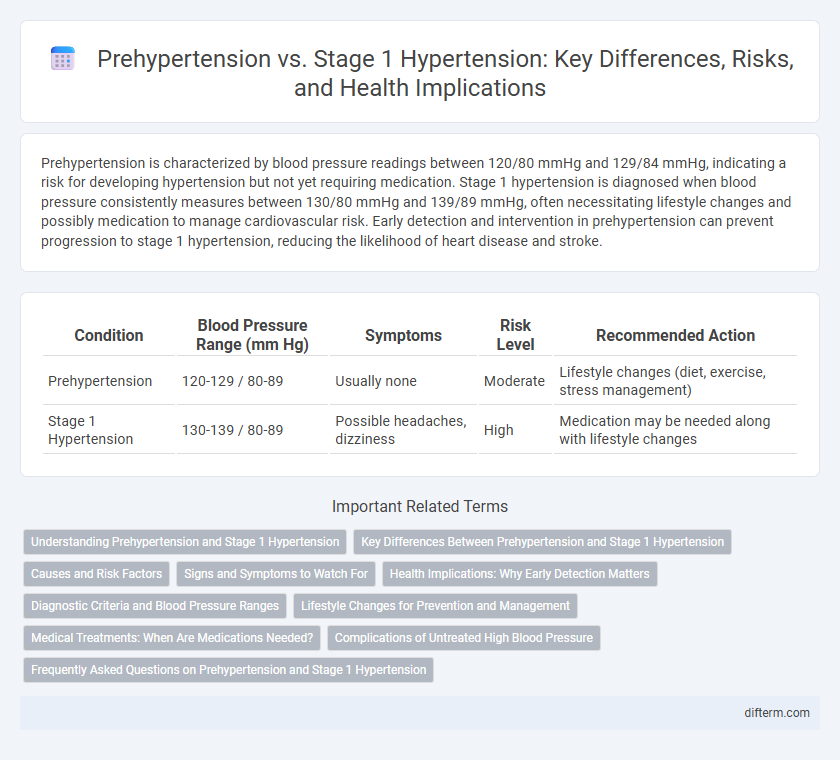Prehypertension is characterized by blood pressure readings between 120/80 mmHg and 129/84 mmHg, indicating a risk for developing hypertension but not yet requiring medication. Stage 1 hypertension is diagnosed when blood pressure consistently measures between 130/80 mmHg and 139/89 mmHg, often necessitating lifestyle changes and possibly medication to manage cardiovascular risk. Early detection and intervention in prehypertension can prevent progression to stage 1 hypertension, reducing the likelihood of heart disease and stroke.
Table of Comparison
| Condition | Blood Pressure Range (mm Hg) | Symptoms | Risk Level | Recommended Action |
|---|---|---|---|---|
| Prehypertension | 120-129 / 80-89 | Usually none | Moderate | Lifestyle changes (diet, exercise, stress management) |
| Stage 1 Hypertension | 130-139 / 80-89 | Possible headaches, dizziness | High | Medication may be needed along with lifestyle changes |
Understanding Prehypertension and Stage 1 Hypertension
Prehypertension is characterized by systolic blood pressure between 120-129 mm Hg or diastolic pressure between 80-89 mm Hg, indicating an increased risk for developing hypertension. Stage 1 hypertension is defined by a systolic pressure of 130-139 mm Hg or diastolic pressure of 80-89 mm Hg, requiring lifestyle modifications and possibly medication to prevent cardiovascular complications. Understanding these classifications helps in early intervention to reduce the risk of heart disease and stroke.
Key Differences Between Prehypertension and Stage 1 Hypertension
Prehypertension is characterized by systolic blood pressure between 120-129 mm Hg and diastolic pressure below 80 mm Hg, indicating elevated risk but not yet classified as hypertension. Stage 1 hypertension is identified with systolic readings from 130-139 mm Hg or diastolic readings between 80-89 mm Hg, requiring medical intervention to prevent cardiovascular complications. The key difference lies in the blood pressure range and associated risk levels, where Stage 1 hypertension demands more aggressive management strategies.
Causes and Risk Factors
Prehypertension is characterized by blood pressure levels ranging from 120-129/80-89 mmHg, primarily caused by factors such as sedentary lifestyle, excessive sodium intake, and obesity. Stage 1 hypertension, with blood pressure between 130-139/80-89 mmHg, often results from persistent stress, chronic kidney disease, and genetic predisposition. Both conditions share risk factors including age, smoking, and diabetes, which contribute to increased cardiovascular disease risk.
Signs and Symptoms to Watch For
Prehypertension typically presents with blood pressure readings between 120-129/80-89 mm Hg and often shows no noticeable signs or symptoms, making regular monitoring crucial. Stage 1 hypertension, defined by readings of 130-139/80-89 mm Hg, may begin to cause symptoms such as headaches, dizziness, or shortness of breath in some individuals. Early detection of elevated blood pressure through consistent measurement is essential to prevent progression and associated cardiovascular risks.
Health Implications: Why Early Detection Matters
Prehypertension, defined by blood pressure levels ranging from 120/80 mm Hg to 129/84 mm Hg, signals an increased risk for progressing to Stage 1 Hypertension, characterized by readings between 130/80 mm Hg and 139/89 mm Hg. Early detection of prehypertension is crucial, as it enables timely lifestyle modifications and medical interventions to prevent cardiovascular diseases, stroke, and kidney damage associated with sustained high blood pressure. Monitoring and managing blood pressure within these early stages significantly reduces the risk of severe health complications and improves long-term outcomes.
Diagnostic Criteria and Blood Pressure Ranges
Prehypertension is characterized by systolic blood pressure ranging from 120 to 129 mm Hg and diastolic pressure below 80 mm Hg, indicating elevated risk without meeting hypertension criteria. Stage 1 Hypertension is diagnosed when systolic pressure ranges from 130 to 139 mm Hg or diastolic pressure falls between 80 and 89 mm Hg, reflecting the need for lifestyle modification and possible medication. Accurate blood pressure measurement and classification according to these ranges are critical for early intervention and prevention of cardiovascular complications.
Lifestyle Changes for Prevention and Management
Prehypertension, defined by blood pressure readings between 120-129/80-89 mmHg, and Stage 1 Hypertension, with readings of 130-139/80-89 mmHg, require targeted lifestyle changes to prevent progression and manage symptoms effectively. Emphasizing dietary modifications such as the DASH diet, regular aerobic exercise, sodium reduction to below 2,300 mg daily, and weight management can significantly lower blood pressure and reduce cardiovascular risk. Limiting alcohol intake, avoiding tobacco use, and managing stress further enhance blood pressure control in individuals with prehypertension and Stage 1 Hypertension.
Medical Treatments: When Are Medications Needed?
Prehypertension is typically managed through lifestyle modifications such as diet, exercise, and stress reduction, while Stage 1 Hypertension may require antihypertensive medications if lifestyle changes are insufficient or if the patient has additional cardiovascular risk factors. Medical guidelines recommend initiating drug therapy for Stage 1 Hypertension when blood pressure consistently exceeds 130/80 mmHg, especially in patients with diabetes, chronic kidney disease, or a history of cardiovascular events. Monitoring blood pressure trends and assessing overall health status are essential to determine when pharmacological intervention becomes necessary.
Complications of Untreated High Blood Pressure
Untreated prehypertension and stage 1 hypertension increase the risk of severe cardiovascular complications, such as heart attack, stroke, and kidney damage. Persistent high blood pressure strains arteries, leading to atherosclerosis and increased risk of heart failure. Early intervention reduces the likelihood of these life-threatening conditions and supports long-term vascular health.
Frequently Asked Questions on Prehypertension and Stage 1 Hypertension
Prehypertension is defined by blood pressure readings between 120-129/80-89 mmHg, signaling an elevated risk but not an immediate hypertension diagnosis, while Stage 1 Hypertension ranges from 130-139/80-89 mmHg, requiring lifestyle changes and sometimes medication. Common FAQs address how to manage prehypertension through diet, exercise, and stress reduction, and when to consult a healthcare provider if blood pressure consistently reaches Stage 1 Hypertension. Regular monitoring and understanding the risk factors, such as obesity, age, and family history, are crucial for preventing progression to more severe hypertension stages.
Prehypertension vs Stage 1 Hypertension Infographic

 difterm.com
difterm.com